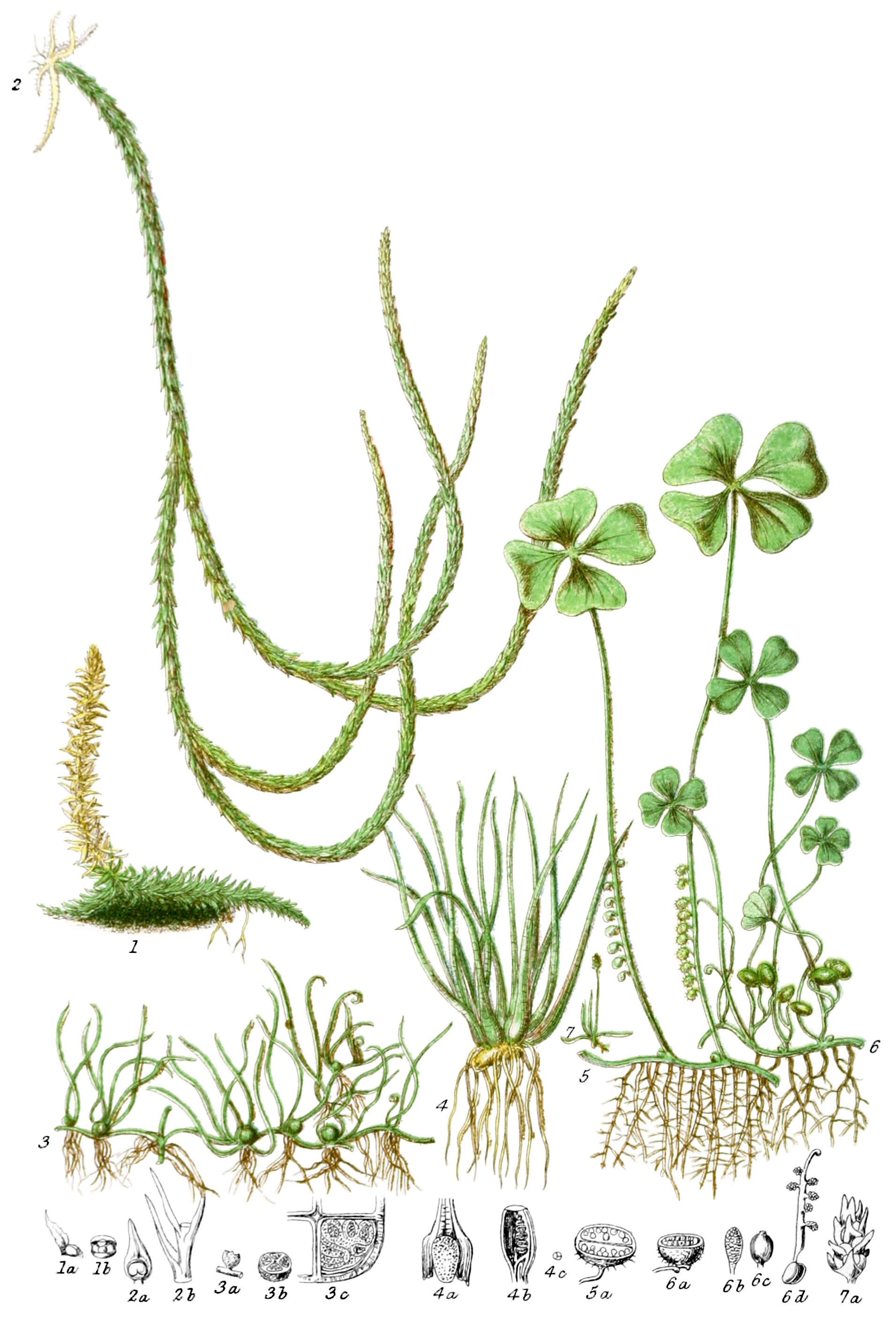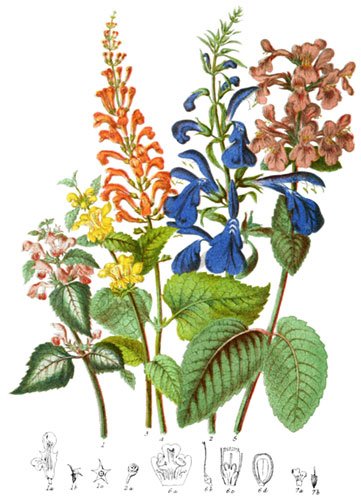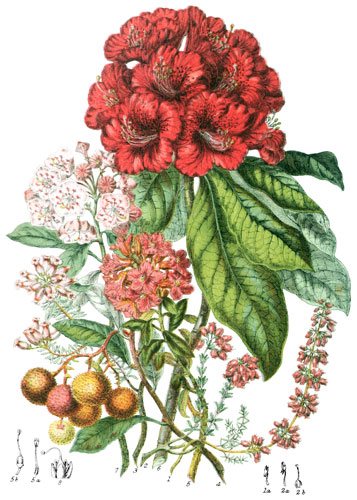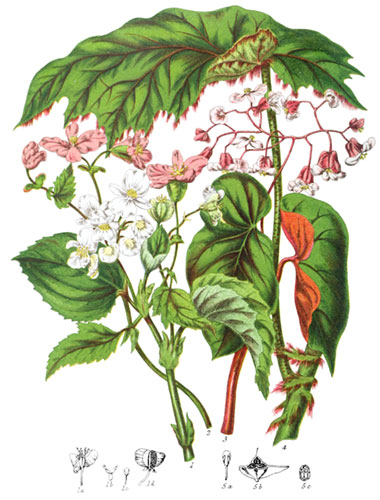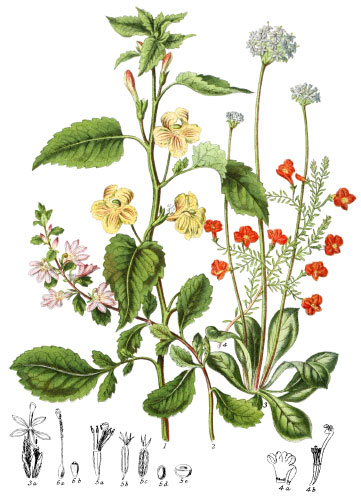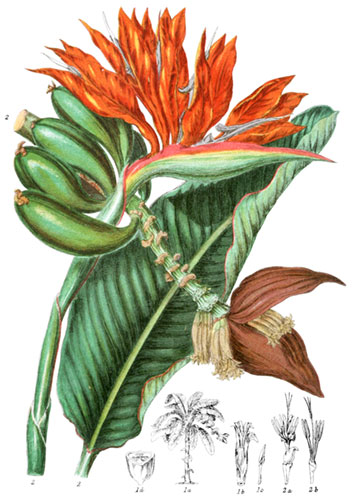Key characteristics
Small herbaceous plants, with creeping stems, and leaves laid over each other, or floating in shallow water with leaves on stalks; sometimes stemless plants, with erect awl-shaped leaves, occasionally rolled up in the bud state. The seeds or spores are contained in cases, one or three-celled, at the base of the leaves, either bursting by distinct valves or whole, and filled with minute powdery matter. The sporules are marked at the top with three small radiating ridges, irregularly rough. The powder is often highly inflammable. The fructification of Marsilea and others is of two kinds,—enclosed in involucres either clustered and stalked, or simple oval bodies which germinate, springing either from the root or from the leaf-stalks.
The annular vessels in the stem of Lycopodium connect this Tribe with the Ferns. In general aspect, some species bear close resemblance to Mosses.
A few of these plants possess medical properties; others are useful in dyeing.
Select plants in this order
Not all plants listed are illustrated and not all plants illustrated are listed.
- Lycopodium, the type of this Order, is said to be derived from the Greek for wolf’s-foot, because of the form of the roots.
- L. inundatum (1) is found only in marshy or boggy places, or on commons where the turf has been pared off, as in several parts of Esher Common, Surrey. It is one of the smallest examples of the genus in England. It has a singular appearance, uplifting its spikes of fructification from the black peat earth.
- L. clavatum is the common club-moss of the north of Britain, very abundant on Highland moors, trailing for a considerable distance over the ground, bearing twin spikes of fructification. The stems are extremely rough, closely beset with small leaves, and are often troublesome to cattle by entangling their feet. The sulphur-coloured capsules contain copious minute seeds, which explode readily, and are much used in Germany for fireworks, or artificial lighting in theaters. From their extreme lightness they are useful in various delicate experiments.
- L. acrostachyum (2) is found on trees, banks, and similar situations in the country around Singapore, where the long drooping branches descend in a graceful manner, branching in forks, terminating in slender spikes of fructification; the scale-like leaves arranged in four rows. The fibrous roots are clothed with grey down.
- L. helveticum is abundant in Switzerland and Tyrol, and now generally employed in our conservatories as a verdant ornament throughout the year.
- L. phlegmaria is East Indian, parasitic on trees, from whence it frequently hangs with tufted branches a foot in length.
- L. squamatum is remarkable for its hygrometrical properties: when uprooted and dry, rolling up into a ball; if placed in water, expanding again into a spreading flat shape. Martius found it in the provinces of Bahea and Pernambuco, in South America; and it may be often seen in botanical museums, affording a striking proof of the extraordinary nature of vegetable tissue thus for years preserving its capacity for imbibing moisture and parting from it.
- In New Zealand L. volubile climbs over bushes in the Bay of Islands, with its tough rigid stalk, and spikes on forked branches.
- L. arbuscula was found by Vancouver at Owhyhee.
- Many species belong to the East Indies:—L. nummularifolium has round leaves and drooping spikes; L. diaphanum grows in all parts of Tristan d’Acunha; L. serratum in Japan.
- L. crassum, resembling the British L. Selago, is a native of the Andies, near Antisana, so widely is this genus dispersed over the world.
- Philularia (3) usually inhabits moist grassy parts of heaths, overflowed during winter; the slender awl-shaped leaves are curled up at first like those of ferns; the spore-cases are placed at the base of the leaves.
- The capsules of Isoetes (4) are lodged in the enlarged base of the leaf, and contain angular spores on slender receptacles; it is rarely found in Britain, except at the bottom of some of the Scotch lakes.
- Marsilea differs from other plants of this tribe, in having flat leaves; but shows trace of imperfect development in some of the stalks, bearing no leaf on their summit.
- The capsules of M. polycarpa (5) are downy at first, but become smooth afterwards.
- Those of M. quadrifolia (6) are in pairs, and stalked.
- The leaves of M. vestita of Columbia are clothed with hairs.
- Phylloglossum (7) is one of the minutest of plants, combining the growth of Isoetes with the fructification of Lycopodium.
- Salvinia and Azolla, both natives of Australia, have rough globose capsules, containing inner spore-cases, filled with small yellow spores.
- Lycopodium is of use in dyeing wool in Scotland and other countries.
Locations
This Tribe is most abundant in hot damp localities, particularly in small Tropical islands; but some species are dispersed in all parts of the world, in ditches and inundated places. Lycopodium covers vast tracts in Lapland.
Legend
- Lycopodium inundatum, Marsh Club-moss. Wet commons, England.
- Spore-case and leaf.
- Spore-case, opening.
- Lycopodium acrostachyum, Parasitic Club-moss. Singapore.
- Spore-case and leaf.
- Stalk, magnified.
- Pilularia globulifera, Creeping Pill-wort. Wet commons, England.
- Bud.
- Section of Capsule.
- Section, magnified.
- Isoetes setacea, Quill-wort. Lakes, Scotland.
- Capsule.
- Section.
- Spore.
- Marsilea polycarpa, Many-seeded Marsilea. Ditches, Demerara.
- Section of capsule.
- Marsilea quadrifiolia, Four-leaved Marsilea. Europe.
- Section of fruit.
- Pollen case.
- Spore-case.
- Stalk-bearing Spores.
- Phylloglossum Drummondii, entire plant, natural size.
- Spike of fructification, magnified.
Explore more
Posters
Decorate your walls with colorful detailed posters based on Elizabeth Twining’s beautiful two-volume set from 1868.
Puzzles
Challenge yourself or someone else to assemble a puzzle of all 160 botanical illustrations.
